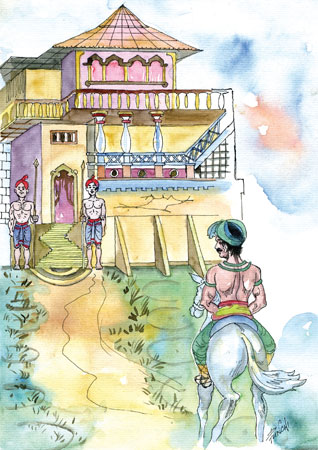The Anuradhapura Kingdom
by Husna Inayathullah
Anuradhapura was the first Kingdom established in ancient Sri Lanka.
It was founded by King Pandukabhaya in 377 BC.
The kingdom's authority extended throughout the country, although
several independent areas emerged from time to time, which grew more
numerous towards the end of the kingdom.

King Pandukabhaya of Anuradhapura was seen as the supreme ruler of
the country throughout the Anuradhapura period. Buddhism played a strong
role in the Anuradhapura period, influencing its culture, laws and
methods of governance. King Pandukabhaya ruled Anuradhapura for 70
years.
Society and culture were revolutionised when the faith was introduced
during the reign of Devanampiya Tissa.
The cultural change was further strengthened by the arrival of the
Sacred Tooth Relic of the Buddha in Sri Lanka and the patronage extended
to it by her rulers.
Invasions from South India were a constant threat throughout the
Anuradhapura period. Rulers such as Dutthagamani, Valagamba, and
Dhatusena are noted for defeating the South Indians and regaining
control of the kingdom. Other rulers who are notable for military
achievements include Gajabahu I, who launched an invasion against the
invaders, and Sena II, who sent his armies to assist a Pandyan prince.
Agriculture
As the kingdom was largely based on agriculture, the construction of
irrigation works was a major achievement of the Anuradhapura Kingdom,
ensuring water supply in the dry zone and helping the country grow
self-sufficient. Several kings, notably Vasabha and Mahasena, built
large reservoirs and canals, which created a vast and complex irrigation
network in the Rajarata area throughout the Anuradhapura period.
The constructions are an indication of the advanced technical and
engineering skills used to create them. The famous paintings and
structures at Sigiriya; the Ruwanwelisaya, Jetavana stupas, and other
large stupas; massive buildings such as Lovamahapaya; and religious
works (such as the numerous Buddha statues) are landmarks demonstrating
the Anuradhapura period's advancement in sculpting.
In 543 BC, Prince Vijaya arrived in Sri Lanka, having been banished
from his homeland in India.
He eventually brought the island under his control and established
himself as king. After this, his followers established villages and
colonies throughout the country.
One of these was established by Anuradha, a minister of King Vijaya,
on the banks of a stream called Kolon and was named Anuradhagama. In 377
BC, King Pandukabhaya made it his capital and developed it into a
prosperous city. Anuradhapura was named after the minister who first
established the village and after a grandfather of Pandukabhaya who
lived there.
The name was also derived from the city's establishment on the
auspicious asterism called Anura. Anuradhapura was the capital of all
the monarchs who ruled the country during in the Anuradhapura Kingdom,
with the exception of Kashyapa I (473-491), who chose Sigiriya to be his
capital.
King Pandukabhaya fixed village boundaries in the country and
established an administrative system by appointing village headmen.
He built hermitages, houses for the poor, cemeteries, and irrigation
tanks. He brought a large portion of the country under the control of
the Anuradhapura Kingdom.
However, it was not until the reign of Dutthagamani (161-137 BC) that
the whole country was unified under the Anuradhapura Kingdom. He
defeated 32 rulers in different parts of the country before he killed
Elara, the South Indian ruler who was occupying Anuradhapura, and
ascended to the throne.
The chronicle Mahavamsa describes his reign with much praise, and
devotes 11 chapters out of 37 for his reign.
He is described as both a warrior king and a devout Buddhist. After
unifying the country, he helped establish Buddhism on a firm and secure
base, and built several monasteries and shrines including the Ruwanweli
Seya and Lovamahapaya. |

